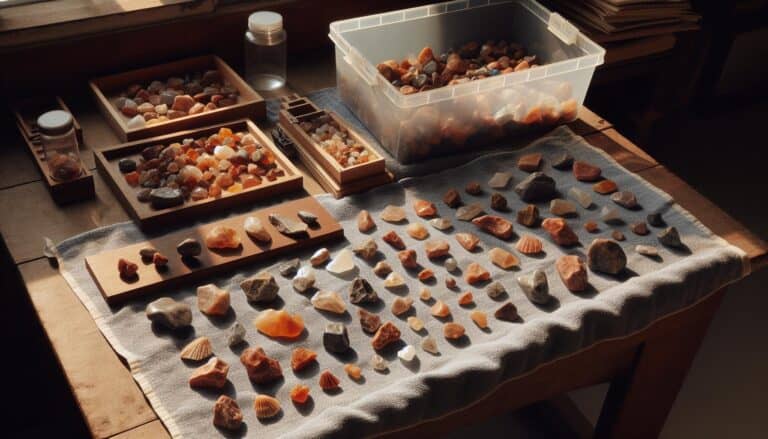Crafting handmade jewelry isn’t just a creative outlet—it’s also a way to share your art with the world.
But when it’s time to turn your passion into profit, pricing can be a real puzzle. You want to ensure your prices reflect the value of your work without scaring away potential customers.
You’re not alone in this challenge. Many artisans struggle with finding that sweet spot for their pricing. It’s a delicate balance between covering your costs, valuing your time, and staying competitive.
Let’s dive into the key strategies that’ll help you price your handmade jewelry just right.
To price handmade jewelry, calculate material and overhead costs, add labor (e.g., $20/hr for 3 hours = $60), totaling costs at $100. Double or triple this for profit, setting prices between $200-$300. Stay competitive by researching similar artisans and adjust based on feedback and market trends.
Value of Your Handmade Jewelry
Recognizing the true value of your handmade jewelry involves more than just tallying up material costs and time spent creating each piece. It’s essential to consider the unique aspects that set your work apart from mass-produced items.
This distinction is at the heart of your jewelry’s value proposition and should be transparent in your pricing.
When determining the value of your jewelry, reflect on the craftsmanship, the intricacy of your designs, and the originality of your pieces. Are they made from high-quality materials or incorporate a unique technique that you’ve perfected over years? Remember, your customers aren’t just buying a product; they’re investing in a piece of art that tells a story or carries a personal significance.
Moreover, factor in the time you invest in perfecting your craft. Continuous skill improvement, attending workshops, and staying updated with the latest trends enable you to command higher prices. These elements contribute to establishing a premium brand image that, if communicated effectively, justifies the value behind your work.
Costs often overlooked include:
- Marketing efforts
- Packaging
- Post-sale services like adjustments or repairs
- Operating expenses of your workspace
- The breadth of your collection
Your pricing strategy should also be dynamic. Adjust for seasonal demands, special collections, or the introduction of new techniques/materials that enhance your jewelry’s appeal. Keep an eye on the market to ensure your prices remain competitive, but don’t undervalue your artistry—it’s what makes your jewelry exceptional.
It’s crucial to convey this value to your customers. High-quality images, engaging product descriptions, and stories behind your creations can help articulate why your handmade jewelry is worth the price. Educating your customers about the effort and uniqueness of your work will go a long way in justifying your prices and building a strong customer base that appreciates the art of handmade jewelry.
Researching the Market
Knowledge of the current market is critical when it comes to pricing your handmade jewelry. You’ve got to do your homework and see what’s out there. Begin by checking out competitors. Look for artisans who make similar items and analyze their pricing structure. Are they offering something fundamentally different? How do they position their products in terms of quality and exclusivity?
It’s not just about the competition, though. Understand your target audience and their spending habits. This might involve:
- Conducting surveys
- Analyzing social media trends
- Joining online forums and groups related to jewelry making
Consider the demographics of your customer base. Are they looking for affordable, everyday pieces or more exclusive, high-end creations? By understanding your audience, you’ll be better equipped to set prices that reflect what they’re willing to pay.
Dive into the numbers. Use tools like Google Analytics to track visitor behavior on your site. Which pieces get the most views or inquiries? This data can inform which of your creations are likely to command higher prices.
Additionally, don’t underestimate the power of seasonal trends. Holiday periods and special occasions can influence the types of jewelry in demand. Ensure you’re up to speed with these trends to price your products competitively during peak times.
Remember, the more research you conduct, the more prepared you’ll be to price your jewelry accurately. Keep an eye on changing market conditions and adjust your prices accordingly. Pricing isn’t static; it’s an ever-evolving aspect of your business that thrives on informed decisions based on tangible insights.
Calculating Your Costs
Before setting prices for your handmade jewelry, it’s vital to calculate your costs accurately. Accurately assessing your costs influences not only profitability but also your brand’s positioning in the market. Factor in material costs, including metals, gemstones, and findings, as these directly affect your jewelry’s cost.
Start by itemizing each component you need to create a piece. Then, consider the time you invest in making each item. Time is money, so determine an hourly rate for yourself and add this to the cost of materials. This calculation, known as Direct Labor costs, accounts for the hands-on work you put into every piece.
Beyond direct materials and labor, remember to include overhead expenses. Overhead includes the indirect costs associated with running your business, such as:
- Studio rent
- Utilities
- Equipment depreciation
- Marketing expenses
Divide total overhead by the number of pieces you can realistically make in a month to get the per-item overhead cost. Now add the material, labor, and overhead per item to get the total cost of each piece of jewelry.
To help organize and analyze these figures, consider this simple breakdown:
| Item | Cost |
|---|---|
| Materials | $XX.XX |
| Direct Labor | $XX.XX / hour |
| Overhead | $XX.XX / item |
| Total Cost | $XX.XX |
Pricing handmade jewelry involves not just covering costs but also ensuring a profit margin. Once you’ve determined the total cost, it’s common to apply a markup—typically two to three times the cost—to set the retail price. Remember, the markup not only accounts for profit but also has to cover any discounts, sales, or commission fees from third-party sellers.
Bear in mind, pricing isn’t static. Regularly review your costs because market prices for materials can fluctuate, and overhead expenses can change. Adjust your pricing accordingly to remain competitive while still ensuring that every sale contributes positively to your business.
Factoring in the Value of Your Time
When pricing your handmade jewelry, one critical component you can’t afford to overlook is the value of your time. As a craftsperson, the hours you pour into creating each piece are as precious as the materials you use. Establishing an hourly wage for yourself ensures that you’re compensated for every minute of labor.
Start by determining a reasonable wage based on your skill level, experience, and the complexity of your work. Consider what professionals in similar fields make and use this as a benchmark. Attach an hourly rate to the time spent on tasks such as:
- Designing jewelry
- Sourcing materials
- Actual production time
- Finishing and packaging
By tracking the time spent on each of these components, you’ll gain insight into where most of your effort is being invested.
Setting Your Hourly Rate
Here’s a simplified example to help you establish an hourly rate:
| Activity | Time Spent (hours) | Hourly Rate ($/hr) | Cost ($) |
|---|---|---|---|
| Designing | 2 | 20 | 40 |
| Sourcing Materials | 1 | 20 | 20 |
| Production | 4 | 20 | 80 |
| Finishing and Packaging | 1 | 20 | 20 |
Total Cost for Time: $160
The table illustrates the financial value of your time based on a chosen hourly rate. Adjust this rate as needed to reflect the uniqueness and quality of your work.
Adjusting as You Grow
As you gain more expertise and your brand becomes recognized, it’s perfectly acceptable to increase your hourly rate. Your experience adds value to your jewelry, and it’s important that your prices reflect this over time.
Remember that your pricing strategy is not static. It will evolve, just like your skill set and reputation. Regular reviews and adjustments will help ensure that your prices always fairly compensate for the time and expertise you bring to your jewelry-making business. As you incorporate the cost of your time into your pricing strategy, keep an eye on how the market responds and be prepared to adjust accordingly.
Setting Competitive Prices
Understanding the market is crucial when you’re setting prices for your handmade jewelry. It’s not just about covering costs but also about knowing what customers are willing to pay for similar items. Conduct a competitive analysis by researching what other artisans are charging for comparable work. Here’s how to dive into market research:
- Visit online marketplaces where handmade jewelry is sold.
- Check out brick-and-mortar stores that carry items similar to yours.
- Attend craft fairs or jewelry expos to gather insight.
- Analyze the pricing strategies of competitors with similar skills and styles.
The goal is to find a sweet spot where your prices are competitive yet still reflect the value and uniqueness of your creations. But remember, direct comparisons may not always be valid; distinguish your jewelry through its quality, design, or story to justify higher pricing, if applicable.
Market conditions can change, so it’s important to stay informed about trends and preferences. If there’s a surge in demand for a specific type of jewelry you make, you may have the opportunity to adjust your prices accordingly. Moreover, if your brand gains popularity or you feature in notable publications, these are factors that can increase perceived value and support higher pricing.
Keep these key things in mind:
- Aim to balance competitiveness with profitability.
- Keep an eye on trends and shifts in the jewelry market.
- Harness the unique aspects of your brand to justify your pricing.
- Regularly reassess your competitive landscape to make informed pricing decisions.
By staying adaptable with your pricing strategy and grounded in market realities, you’ll be better positioned to attract customers without selling yourself short. Remember to periodically reassess your position in the market and adjust as necessary to keep your handmade jewelry business thriving.
Conclusion on Selling Jewelry
Mastering the art of pricing your handmade jewelry is a dynamic process that demands attention to detail and an understanding of your market.
It’s about striking that perfect balance where your unique creations are both competitively priced and profitable. Embrace the distinct qualities of your brand to stand out and ensure your prices reflect the value you offer. Remember, regular market analysis is key—stay alert to trends and shifts to keep your pricing strategy sharp. With these insights, you’re well-equipped to not only attract customers but also to sustain and grow your jewelry business.
Keep adapting, and you’ll find the sweet spot that resonates with your audience and your bottom line.


![Delaware Rockhounding Sites in [year]: Location & Hidden Gems](https://observationhobbies.com/wp-content/uploads/2024/01/OlSBM_jZS8pYfIDXCzqu-768x439.jpg)

![Illinois Rockhounding Sites in [year]: Best Spots & Finds](https://observationhobbies.com/wp-content/uploads/2024/01/bD90IrQO6PXFhraASvW2C-768x439.jpg)


